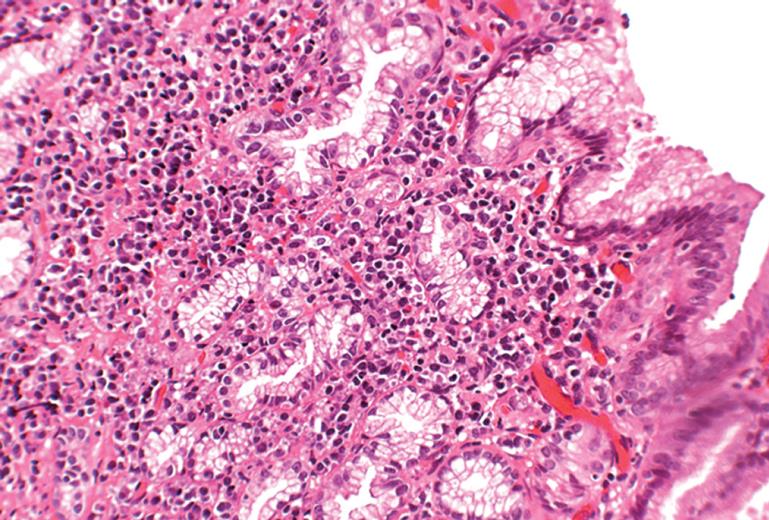Published online Apr 14, 2008. doi: 10.3748/wjg.14.2268
Revised: February 19, 2008
Published online: April 14, 2008
We describe the case of a 68-year-old otherwise healthy male who presented to our emergency room with signs and symptoms of acute appendicitis. Exploratory surgery revealed a normal appendix. Further examination revealed an enlarged lymph node-like mass of tissue near the appendix, in the ileocecal mesentery. This mass was removed and was found to be inflamed heterotopic gastric tissue. Although reports of heterotopic gastric tissue in the literature are common, we believe that this case represents the first report of inflamed heterotopic gastric tissue simulating appendicitis.
- Citation: Bender E, Schmidt SP. Extraintestinal heterotopic gastric tissue simulating acute appendicitis. World J Gastroenterol 2008; 14(14): 2268-2269
- URL: https://www.wjgnet.com/1007-9327/full/v14/i14/2268.htm
- DOI: https://dx.doi.org/10.3748/wjg.14.2268
Reports of the occurrence of heterotopic gastric tissue in the medical literature are common. Von Radhen et al[1] and Steele et al[2] have recently published case reports that included extensive reviews of the literature on this topic. Heterotopic gastric mucosa has been described in the esophagus and in the oral cavity, as a polyp in the distal ileum, as a mass in the rectum and anus, in the scrotum, in the hepatobiliary system, including the gallbladder and common bile duct, in the mediastinum and in the spinal cord. Typically heterotopic gastric tissue is asymptomatic. In contrast, we present a report of gastric heterotopia in a patient who presented at our institution with signs and symptoms of acute appendicitis. To our knowledge, this presentation of heterotopic gastric mucosa is unique to the medical literature.
The patient was a previously healthy 68-year-old male whose past medical history was significant only for benign prostatic hypertrophy treated with Cardura. He presented to the emergency room with approximately 6 h of right lower quadrant pain and nausea. The pain had started in the peri-umbilical area and had localized to the right lower quadrant by the time of his presentation. The patient denied having had this type of pain previously. On examination, the patient was tender in the right lower quadrant with voluntary guarding and a positive obturator sign. His white blood cell count was 10 000 with 89% granulocytes. His abdominal films showed a mild ileus pattern with no evidence of obstruction or free air.
The patient was taken to the operative suite and explored through a McBurney incision. A small amount of straw colored ascites was found upon entrance to the abdomen. The appendix was exceptionally long. However, it did not show any signs of inflammation. However, near the appendix, in the ileocecal mesentery, there was what appeared to be an enlarged, inflamed lymph node. This tissue was removed and sent to pathology for permanent stains. There was no evidence of a Meckel’s diverticulum upon examination of the distal two feet of ileum. The right colon was otherwise normal in appearance and by palpation.
The tissue that had been thought to be an enlarged, inflamed lymph node was removed and established by pathology to be gastric heterotopic tissue with evidence of inflammation/gastritis (Figure 1).
Postoperatively, the patient’s pain resolved. He was maintained on Prevacid (30 mg once daily) due to the concern that he might have additional areas of gastric heterotopic tissue. However, a technetium-99 scan did not show any areas of uptake postoperatively and he remains asymptomatic three years postoperatively.
We are presenting what we believe to be the first case of extraintestinal heterotopic gastric tissue with inflammation simulating appendicitis. The 2004 literature review by von Rahden et al[1] noted that heterotopic gastric mucosa has been found in the upper esophagus where it can lead to inflammation and esophageal webbing. A heterotopic gastric mucosa has also been found in Meckel’s diverticula. According to Cserni[3] the reflux-type gastritis or gastropathy in Meckel’s diverticula may account for some symptoms that have prompted removal of appendixes without inflammation.
The authors have searched the literature for similar cases simulating appendicitis using search terms including (ectopic or heterotopic) and (gastric or stomach) and (abdominal pain). Case reports were found that reported patients with abdominal pain due to gastric mucosa in the gall bladder or rectum, but these were not characterized as simulating appendicitis.
Stelle et al[2] describes the two prominent theories regarding the origin of gastric heterotopic tissue. One suggests that this is congenitally displaced tissue and it therefore represents choristomas. Another leading theory suggests that the tissue originates from irregular differentiation of multipotential cells rather than displaced embryonic cells.
Regardless of the origin of the tissue, the tissue is known to consist of gastric parietal cells capable of secreting a physiologically effective amount of acid leading to inflammation and occasionally to ulceration. Cserni[3] notes that in most cases, the pathology does not yield evidence of H pylori organisms. There was no sign of H pylori in our specimen.
In conclusion we present what we believe to be the first case of extraintestinal gastric heterotopic tissue simulating appendicitis. We suggest that extraintestinal gastric heterotopia be added to the list of differential diagnoses in patients with acute abdominal pain.
There are no cases reported in the literature wherein heterotopic gastric tissue is described as simulating acute appendicitis.
This is new information that describes a unique presentation of heterotopic gastric tissue.
Although rare, heterotopic gastric tissue could explain pain simulating appendicitis.
Heterotopic means located in an atypical position.
This is a case report of extraintestinal heterotopic gastric tissue simulating appendicitis. It’s very interesting and worth reporting.
| 1. | von Rahden BH, Stein HJ, Becker K, Liebermann-Meffert D, Siewert JR. Heterotopic gastric mucosa of the esophagus: literature-review and proposal of a clinicopathologic classification. Am J Gastroenterol. 2004;99:543-551. |
| 2. | Steele SR, Mullenix PS, Martin MJ, Ormseth E, Weppler E, Graham J, Place RJ. Heterotopic gastric mucosa of the anus: a case report and review of the literature. Am Surg. 2004;70:715-719. |
| 3. | Cserni G. Gastric pathology in Meckel's diverticulum. Review of cases resected between 1965 and 1995. Am J Clin Pathol. 1996;106:782-785. |









